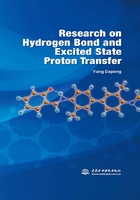
Preface
Hydrogen bonding,as a site-specific electrostatic interaction between hydrogen donor and hydrogen acceptor,is a very important type of weak interactions within molecule or between molecules. It is central to the understanding of the microscopic structure and function in many molecular systems. It also plays an important role on the photophysical and photochemical process of hydrogen-bonded systems in their electronically excited states,such as excited state proton transfer (ESPT).
An optical electronic excitation changes drastically the distribution of electronic density on a scale that is much faster than any nuclear motion. After this instantaneous change,the whole system relaxes to its equilibrium state(s) including electrons,protons and heavier nuclei forming at least two excited states connected by ESPT reaction. The structural prerequisite for this connection is the close location of proton donor and acceptor groups bridged with a hydrogen bond. Hydroxyl or amino groups generally serve as the proton donors,and carbonyl oxygen or azo nitrogen as the proton acceptors. Upon electronic excitation,the redistribution of electronic charge makes the proton donor more acidic and the acceptor more basic.
Basically,the ESPT reaction starts from the ground normal state (N) and returns to the same state after the fully reversible four-level reaction cycle. The absorption of light quantum leads to normal excited-state form (N*). In the course of ESPT,this form converts into the excited photoproduct,the so-called photo tautomer (T*),by the translocation of proton and hence the alteration of the electronic configuration. T*is recognized by fluorescence spectrum strongly shifted to longer wavelengths. The T*relaxation (i.e.,the fluorescence emission plus the decay via radiationless channels) leads to the ground-state tautomer (T) that undergoes a fast back proton transfer with the recovery of N species,closing the reaction cycle. Because of the coupling between charge transfer and proton transfer,the four electronic states,N,T,N*and T*,possess different distribution of charges and hence interact differently with surrounding environment. The significant enhancement in the excited-state basicity/acidity factor,which is several orders of magnitude,makes the ESPT energetically favorable in excited state and explains why the same reaction does not occur in the ground state.
In this book,our recent investigations into the hydrogen bonding effects on excited state proton transfer of chromophores in solution have been reviewed. By monitoring the spectral shifts of some characterized vibrational modes involved in the formation of hydrogen bonds and scanning the potential energy curves or surfaces in different electronic states,it has been demonstrated that ESPT both within one molecule and between different molecules are triggered by the strengthening of hydrogen bonds in excited states. In Chapter 1,knowledge about hydrogen bond and excited state proton transfer is briefly introduced. In Chapter 2,the theoretical foundation of computational methods used in this book,namely time dependent density functional theory (TD-DFT),is briefly introduced.
From Chapter 3 to Chapter 5,we mainly discussed the excited state intramolecular proton transfer based on one single intramolecular hydrogen bond. In Chapter 3,the ESIPT mechanism of phenylbenzimidazole derivatized fluorescent sensor (L) in different solvents was discussed. In Chapter 4,we introduced the ESIPT mechanism of a highly selective fluorescent chemosensor based on 2-hydroxyphenylthiazole. In Chapter 5,we carried out an analogy study on the ESIPT reaction of 3BHC sensor between polar DMF and non-polar toluene.
From Chapter 6 to Chapter 8,we mainly discussed the excited state intramolecular proton transfer based on double intramolecular hydrogen bonds. In Chapter 6,we introduced a competitive excited state dynamical process of 2,2'-((1E,1'E)-((3,3'-dimethyl-[1,1'-biphenyl]-4,4'-diyl)-bis(azanylylidene))bis(methanylylidene))-diphenol system. The excited state behaviors of imide compounds N-cyclohexyl-3-hydroxyphthalimide and 3,6-Dihydroxy-N-Cyclohexy-lphthalimide were discussed in Chapter 7. In Chapter 8,we studied the excited-state proton transfer behaviors of 3H-MC and P2H-CH.
From Chapter 9 to Chapter 11,we mainly discussed the excited state intermolecular proton transfer based on multiple intermolecular hydrogen bonds. In Chapter 9,we discussed the excited state intermolecular proton transfer mechanism of 2-phenylimidazo[4,5-b]pyridine in methanol solvent. The excited state behavior of 2-(phenyl)imidazo [4,5-c]pyridine in methanol solvent was introduced in Chapter 10. In Chapter 11,we discussed the excited state behavior of t-DMASIP-b sensor.
The publication of this book is supported by the Key Scientific Research Project of Colleges and Universities of Henan Province of China (18A140023) and the author also feels very grateful for the support from Department of Mathematics and Statistics of North China University of Water Resources and Electric Power.
Yang Dapeng
November,2017